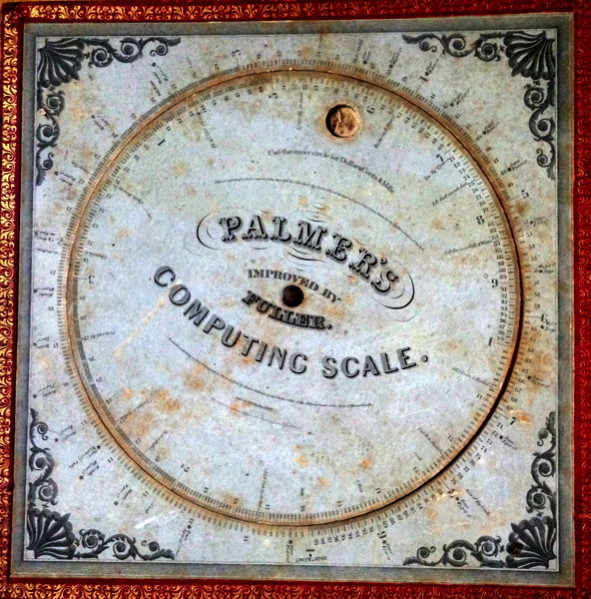
This is issue 4 of the Palmer’s Computing Scale and bearing the inscription “Improved by Fuller” on one side. The original patent date was 1843 entered by Aaron Palmer of the clerks Office, Boston Mass.. But the Patent was purchased by Professor Fuller and improved by him. The Computing Scale bears scales for percentages, monetary transactions and interest.
Fuller’s Time Telegraph on the other side has a patent date of 1845, Boston, Mass. It enables the calculation of the number of days, weeks, or months to be determined between two given dates without calculations.
The scale is described by Hook and Norman1 as:
The instrument is engraved volvelle (by George G. Smith) mounted on heavy cardboard with edges bound with gilt leather strips and is 11” square. It represents one of the earliest applications of the words “computing” to an instrument. At the time a computer usually referred to a person employed to do calculation.
Condition is good with the leather bound sides only slightly marred and the red still bright. The metal control hole is slightly tarnished. The circular scales both move freely. Whilst there is some discoloration to the faces every number and all instructions printed on both sides are very readable.
In 1909 Florian Cajori3 described the components from which this instrument was developed as follows:
80. J. Fuller’s Computing Telegraph.
81. J. Fuller’s Telegraph Computer.
References
- John E. Fuller, Key to Palmer’s Computing Scale: Improvement to Palmer’s Endless Self-Computing Scale and Key, New York, 1846.
- Bobby Feazel, “Palmer’s Computing Scale”, Journal of the Oughtred Society, vol 3, no. 1, March 1994, p. 9.
- Bobby Feazel, “Palmer’s Computing Scale - Revisited”, Journal of the Oughtred Society, vol 4, no. 1, March, 1995, p. 5.
1 Diana H. Hook and Jeremy M. Norman, Origins of Cyberspace: : A Library on the History of Computing and Computer-Related Telecommunications, Norman Publishing, 2002, pp. 269–70. (↑)
2 see Fuller, Key to Palmer’s Computing Scale, 1846, above. (↑)
3 Florian Cajori, The History of the Logarithmic Slide Rule, Engineering news publishing Company, USA, 1909, p. 47. (↑)
Pages linked to this page
 This work by Jim Falk is licensed under a Creative Commons Attribution-NonCommercial-NoDerivs 3.0 Unported License Click on the logo to the left to see the terms on which you can use it.
This work by Jim Falk is licensed under a Creative Commons Attribution-NonCommercial-NoDerivs 3.0 Unported License Click on the logo to the left to see the terms on which you can use it.